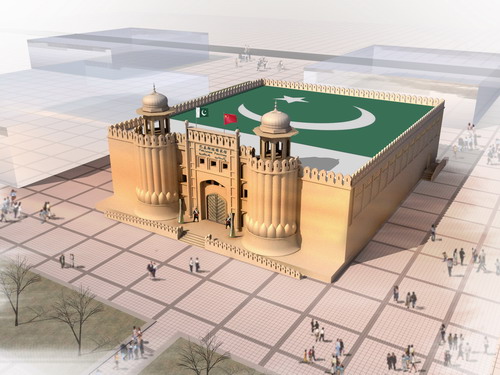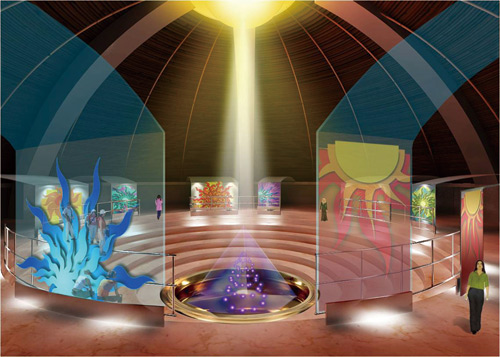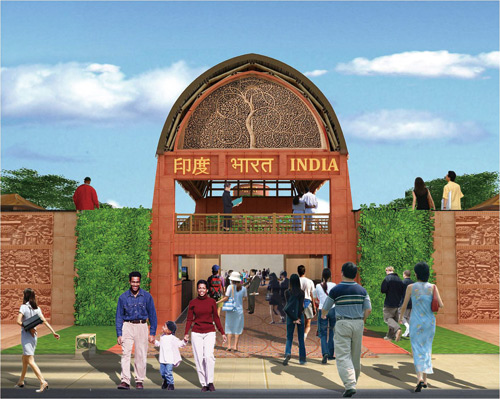Why focus on the political differences and chronic intransigence between India and Pakistan when we have so much in common – we both love to rattle each other with underground nuclear explosions, beat up trouble making minorities, once in while tear down their places of worship, and share a deep rooted passion for kitsch and poorly detailed, state-sponsored architectural expressions.
The pavilion designs for India and Pakistan for the oncoming Shanghai Expo are multi million dollar incongruities at the expense of respective countries’ tax payers. The theme of expo is “Better city, Better life”, a very timely theme indeed when more than half the world’s population live in cities. To which Pakistan comes with a brilliant idea of building a replica of a 16th century fort with Pakistani flag painted on it roof and the Indian design team answers the call with a design that resembles a burial mound for Buddhist relics from 3rd century BC – the Sanchi Stupa.
The centerpiece of the Indian pavilion is a 35m wide dome, claimed as the biggest structure to be made from bamboo — which isn’t too bad for an event where you are expected to show off your one-trick ponies in the name of ‘coolness factor’ and innovation….but a 9 million dollar bamboo dome ? !! you’ve got to be kidding me ! If the whole idea of using bamboo is to demonstrate the relevance, economic incentive and usefulness of locally available natural materials, it would seem a lot more compelling to have the material express itself in the final design. But that doesn’t seem to be the case either. If the sophomoric artist renderings are any proof of what is to be expected, I have a hard time convincing myself that the whole pastiche is made out of bamboo.
But there is more to the dome.The bamboo shell would support a micro concrete roof with a waterproofing membrane (plastic !) with herbs grown on top of it and irrigated by recycled water from toilets (brought to you by gravity defying pumps – what a reversal of rain water harvesting). The herbs will be interwoven with a set of ornamental copper plates and solar photovoltaic cells. They are also throwing in some wind turbines. According to the Mr.D.R. Naidu, vice president of the design firm JWT, , the dome will be used as a 360-degree screen to tell different stories about life in cities through the ages. The entire pavilion is beginning to look more like an over zealous middle school science project on a Republic day float. If simplicity and conceptual elegance has anything to do with sustainability the project would probably get a D-. Perhaps the design was inspired by a wholesome Bollywood fare with equal opportunities for sentimentality, nostalgia, romance, comedy, music, dance and fantasy.
Thankfully there is Pakistan’s pavilion that makes the bamboo dome look a lot less ridiculous. It looks like a convincing movie set from a era when Jinnah and Nehru shared the same brand of cigarette. Perhaps we should also think of this as a green building since the Pakistani designers have come up with a brilliant idea of painting the 2000 sq.meters of roof with the image of Pakistani flag and that’s a lot of green. I guess I have to give credit where credit is due. Given a choice between a boxy replica of a fort and a bamboo dome that represent a religion that is based on non-violence, I would gladly take the dome.
The pavilions from India and Pakistan are going to have a lot of company when it comes to sustainable exhibitionism at a premium price. France is building a gigantic french garden surrounded by water at the cost of 40million Euros (all made from recycled materials of course!), Canadians want to show of living plants and rain water harvesting for 44 million dollars. The Swiss are going for the home run with biodegradable walls made from soy fiber and the entire pavilion power by solar panels at a tidy sum of 19 million dollars.
There is no dearth for talented designers in India. Given the lack of any information on how JWT design was chosen, I am going to assume it was not through an open competition. A well publicized open competition with decent jury may or may not have yielded a better design, but at the very least it would have presented a forum for an open debate allowing for alternative visions from a narrow but significant pool of talented young designers in the country. Too bad we now have to settle for a bad Bollywood movie soaked in ethnocentric nostalgia and sentimentality.
The irony is that it might even be a big hit in China.
More Links:
– Self congratulatory article from “The Hindu”




One comment
Do you want to comment?
Comments RSS and TrackBack URI
Trackbacks